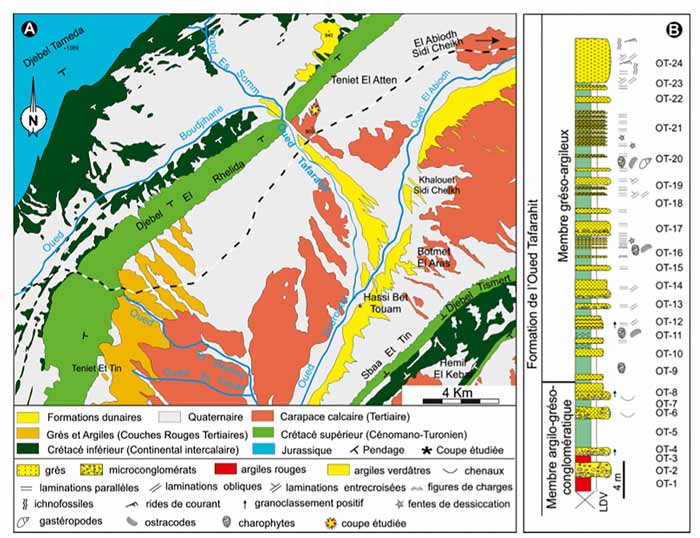April 2021 : publication Annales de Paléontologie
Discovery of lower Ypresian charophytes and ostracods from the Ksour Mountains (Algeria): Biostratigraphy and paleoecology
A stratigraphic, palaeontological and sedimentological study was carried out in the red beds cropping out on the left side of Oued Tafarahit, south-east of the Ksour Mountains (Algeria). The studied succession consists of a non-marine fining-upward detrital formation, including microconglomerate, sandstone and clay beds, which were previously attributed to the Cenozoic sensu lato, since no palaeontological evidence was available. Sedimentology suggests deposition in a fluvial environment. The clayey levels yielded the assemblage formed by the charophytes Peckichara atlasensis, Maedleriella cristellata, Nitellopsis (Tectochara) thaleri, Grovesichara sp., and Lamprothamnium papulosum and the ostracods Neocyprideis meguerchiensis, Herpetocypris? sp. and Cyprinotus? sp. This assemblage allows constraining the age of the detrital series from Oued Tafarahit to the Ypresian. Ostracods are typical of freshwater to euryhaline environments. The freshwater taxa (Herpetocypris? sp. and Cyprinotus? sp.) would indicate phases of desalinisation during periods of flood. However, the brackish water species (Neocyprideis meguerchiensis) is characteristic of saline phases related to low water table periods. Moreover the charophyte and ostracod assemblage confirms a close palaeobiogeographic relationship between North Africa and Southern Europe during the Lower Eocene.

References
Abdelkader Mennad, Mohammed Adaci, Rodolphe Tabuce, Carles Martín-Closas, Madani Benyoucef, Mustapha Bensalah, Olga Otero, Raphaël Sarr, Djamila Zaoui – Discovery of lower Ypresian charophytes and ostracods from the Ksour Mountains (Algeria): Biostratigraphy and paleoecology – Annales de Paléontologie Vol. 107, Issue 1, January–March 2021, 102466. https://doi.org/10.1016/j.annpal.2020.102466




